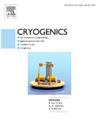Energy conversion and loss characteristics of multi-stage cryogenic submerged pumps based on power density evolution model
IF 2.1
3区 工程技术
Q3 PHYSICS, APPLIED
引用次数: 0
Abstract
Cryogenic submerged pumps (CSPs) are imperative for the efficient transport of cryogenic fluids; however, their multi-stage energy conversion mechanisms remain insufficiently understood under extreme operating conditions. This study aims to quantitatively elucidate the internal flow field and energy transfer characteristics of a two-stage CSP by developing an energy conversion and loss analysis method based on power density distribution. This method integrates high-fidelity numerical simulations and experimental validation using liquid nitrogen. The results reveal that the first-stage impeller is highly sensitive to inlet flow disturbances under off-design conditions, with local flow separation increasing turbulence intensity and energy dissipation; the deviation proportion (DP) in certain channels exceeds 15%. Conversely, the second-stage impeller exhibits a more uniform power density distribution and maintains stable outlet pressure even at 1.4Qd, where its kinetic energy increment extends to a streamline distance of 0.36 compared to 0.2 in the first stage. Guide vanes account for 65 % of the total turbulent dissipation power and 59 % of wall friction loss, with peak kinetic-to-pressure energy conversion efficiency occurring at a streamline distance of 0.3. Both the impeller and guide vanes exhibit similar energy transfer processes: power density increases slightly at the inlet, decreases gradually along the channel, and rebounds near the outlet. These findings clarify inter-stage synergy and loss mechanisms while providing quantitative design guidance for optimising impeller–guide vane matching, thereby improving overall efficiency and expanding the high-efficiency operating range of multi-stage CSPs.
基于功率密度演化模型的多级低温潜水泵能量转换及损耗特性研究
低温潜水泵(CSPs)是低温流体高效输送的必要条件;然而,在极端操作条件下,它们的多级能量转换机制仍然没有得到充分的了解。本研究旨在通过建立一种基于功率密度分布的能量转换和损失分析方法,定量地阐明两级光热发电的内部流场和能量传递特性。该方法将高保真数值模拟与液氮实验验证相结合。结果表明:在非设计工况下,一级叶轮对进口气流扰动高度敏感,局部流动分离增加了湍流强度和能量耗散;某些信道的偏差比例(DP)超过15%。相反,二级叶轮的功率密度分布更加均匀,即使在1.4Qd时也保持稳定的出口压力,其动能增量从一级的0.2扩展到0.36的流线距离。导叶占总湍流耗散功率的65%,占壁面摩擦损失的59%,动压能量转换效率在流线距离为0.3时达到峰值。叶轮和导叶均表现出相似的能量传递过程:功率密度在进口处略有增加,沿通道逐渐降低,在出口附近反弹。这些发现阐明了级间协同和损失机制,同时为优化叶轮-导叶匹配提供了定量设计指导,从而提高了多级csp的整体效率,扩大了其高效运行范围。
本文章由计算机程序翻译,如有差异,请以英文原文为准。
求助全文
约1分钟内获得全文
求助全文
来源期刊

Cryogenics
物理-热力学
CiteScore
3.80
自引率
9.50%
发文量
0
审稿时长
2.1 months
期刊介绍:
Cryogenics is the world''s leading journal focusing on all aspects of cryoengineering and cryogenics. Papers published in Cryogenics cover a wide variety of subjects in low temperature engineering and research. Among the areas covered are:
- Applications of superconductivity: magnets, electronics, devices
- Superconductors and their properties
- Properties of materials: metals, alloys, composites, polymers, insulations
- New applications of cryogenic technology to processes, devices, machinery
- Refrigeration and liquefaction technology
- Thermodynamics
- Fluid properties and fluid mechanics
- Heat transfer
- Thermometry and measurement science
- Cryogenics in medicine
- Cryoelectronics
 求助内容:
求助内容: 应助结果提醒方式:
应助结果提醒方式:


